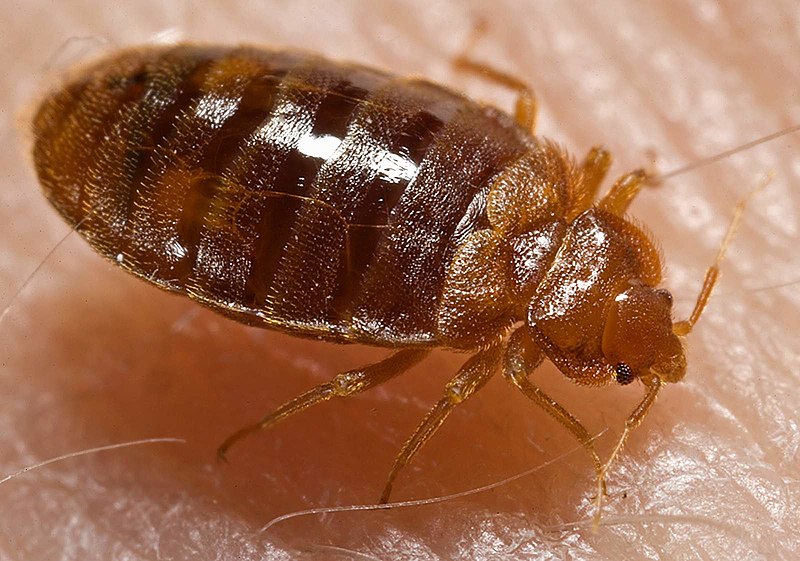Common Bed Bug
- Article
- Common Bed Bug
Common Bed Bug
Scientific Name: Cimex lectularius
How to identify common bed bug
Bed bugs are parasitic insects of the cimicid family that feed exclusively on blood. Cimex lectularius, the common bed bug, is the best known, as it prefers to feed on human blood. Bed bug bites are caused primarily by two species of insects: Cimex lectularius (the common bed bug) and Cimex hemipterus, found primarily in the tropics. Their size ranges between 1 and 7 mm. They spread by crawling between nearby locations or by being carried within personal items. Infestation is rarely due to a lack of hygiene but is more common in high-density areas.

Where are common bed bugs commonly found?
Bed bugs spend much of their time in dark, hidden locations like mattress seams, or cracks in a wall.
Why are common bed bugs considered a pest?
Bed Bugs are not know to transmit disease but they do cause a variety of negative physical health, mental health and economic consequences. Many people have mild to severe allergic reaction to the bites with effects ranging from no reaction to a small bite mark to, in rare cases, anaphylaxis (severe, whole-body reaction). These bites can also lead to secondary infections of the skin such as impetigo, ecthyma, and lymphanigitis. Bed bugs may also affect the mental health of people living in infested homes. Reported effects include anxiety, insomnia and systemic reactions.
What is the biology and lifecycle of common bed bugs?
Adult Cimex are light brown to reddish-brown, flat, oval, and have no hind wings. The front wings are vestigial and reduced to pad-like structures. Adults grow to 4–5 mm (0.16–0.20 in) long and 1.5–3 mm (0.059–0.118 in) wide. Female common bed bugs can lay 1–10 eggs per day and 200–500 eggs in their lifetime, whereas female tropical bed bugs can lay about 50 eggs in their lifetime.
Bed bugs have five immature nymph life stages and a final sexually mature adult stage. Bed bugs need at least one blood meal in order to advance to the next stage of development. They shed their skins through ecdysis at each stage, discarding their outer exoskeleton. Newly hatched nymphs are translucent, lighter in color, and become browner as they moult and reach maturity. Bed bugs may be mistaken for other insects, such as booklice, small cockroaches, or carpet beetles; however, when warm and active, their movements are more ant-like, and like most other true bugs, they emit a characteristic disagreeable odor when crushed.
Management Tips for Common Bed Bug
A licensed pest control operator must only apply pesticides that are currently registered and permitted for use by the Australian Pesticides and Veterinary Medicines Authority (APVMA) for the control of bed bugs. The pesticide applied will be selected on its usage patterns. For example, dust is excellent at penetrating voids and cracks where bed bugs reside, but would not be as effective in a location where it can be dispersed by foot traffic and vacuuming.
Pesticide sprays are also used for the treatment of bed bugs. A product with a residual formulation is used and any risk areas of potential bed bug infestations are targeted. It is important to ensure accurate and direct application to target areas such as beading on mattresses, cracks and crevices in furniture and flooring If the pest control operator completes an inaccurate space spray, the fine droplets can excite the bed bugs. This in turn can cause them to excrete alert pheromones and can disperse the infestation to other areas.
It is important to consult the pesticide label before use as some pesticides cannot be applied to mattresses. At the end of the treatment the room should be well ventilated and re-entry periods observed. A follow up treatment visit should be conducted in about a week, to allow for hatching of eggs, and pesticide re-applied where necessary. The clients should be advised to limit the amount of cleaning so that the residual pesticide is not removed. Sprays may kill the bed bugs but they are ineffective on the eggs.
PRODUCT SOLUTIONS
-
 Seclira Pressurised Insecticide 397g5g/kg Dinotefuran
Seclira Pressurised Insecticide 397g5g/kg DinotefuranSeclira Pressurised Insecticide is a fast-acting, non-repellent, ready-to-use product with System III compatibility for the control of a broad range of pests including ants, and cockroaches.
-
 Fendona Plus 60SC Insecticide60g/L Alpha-Cypermethrin
Fendona Plus 60SC Insecticide60g/L Alpha-CypermethrinFendona Plus 60SC Insecticide is a residual insecticide for control of ants, cockroaches, silverfish, fleas, flies, mosquitos bed bugs, meal moths and spiders in domestic, industrial, commercial and public health situations and for the control of litter beetles in poultry sheds.
-
 Ficam W Insecticide800g/kg Bendiocarb
Ficam W Insecticide800g/kg BendiocarbFicam W Insecticide is a non-repellent, broad-spectrum residual spray registered for the control of cockroaches, flies, spiders, fleas, ants, silverfish, bed bugs, millipedes and other insect pests.
-
 Coopex Dust Insecticidal Dusting Powder10g/kg Permethrin
Coopex Dust Insecticidal Dusting Powder10g/kg PermethrinCoopex Dust Insecticidal Dusting Powder is registered for the control of cockroaches, ants, fleas, silverfish and bed bugs in and around domestic and industrial premises, food preparation and storage areas. Also for control of mushroom flies in mushroom housing and bees in wall cavities.
-
 Coopex Residual Insecticide250g/kg Permethrin
Coopex Residual Insecticide250g/kg PermethrinCoopex Residual Insecticide is a wettable powder registered for the residual control of cockroaches, ants, carpet beetles, spiders, clothes moths, bed bugs, silverfish and mosquitoes.
Out of stock -
 Fury 120 SC Insecticide 1L80g/L Bifenthrin, 40g/L Alpha-Cypermethrin
Fury 120 SC Insecticide 1L80g/L Bifenthrin, 40g/L Alpha-CypermethrinFury 120 SC Insecticide is specifically formulated to create a superior, longer-lasting strength general insecticide that works in two powerful ways to rid your clients of all general household pests.
-
 Chaindrite Extra Strength Crawling Insect Spray1.4g/kg Imiprothin and 2g/kg Cypermethrin
Chaindrite Extra Strength Crawling Insect Spray1.4g/kg Imiprothin and 2g/kg CypermethrinChaindrite Crawling Insect Spray is a new low odour oil-based professional aerosol insecticide with a powerful flush and kill effect on cockroaches. Chaindrite is an easy to apply aerosol “without the splutter”.This product is an excellent knockdown and flushing agent and has long term residual activity.
-
 Shieldrite Crawling Insect Foam 350g0.5g/kg Imidacloprid
Shieldrite Crawling Insect Foam 350g0.5g/kg ImidaclopridShieldrite Crawling Insect Foam is a non repellent suspension concentrate formulated into a ready to use foam for the use in the management of pest insects including Termites, European wasps, Ants, Cockroaches and Bed bugs.
-
 Maxum PRO 125 SC Insecticide 500mL125g/L Beta Cyfluthrin
Maxum PRO 125 SC Insecticide 500mL125g/L Beta CyfluthrinMaxumPRO is a robust, fast-acting, knock-down, broad spectrum insecticide for general insect control in domestic and commercial situations, as well as for the control of pest insects of turf and ornamental plants.
-
 Battleaxe Pro Aerosol 420g20g/kg propoxur, 2g/kg tetramethrin, 10g/kg piperonyl butoxide
Battleaxe Pro Aerosol 420g20g/kg propoxur, 2g/kg tetramethrin, 10g/kg piperonyl butoxideBattleaxe PRO Professional Crack & Crevice is an aerosol formulation containing both long lasting and vapour-acting knockdown components.
-
 Demand Duo Insecticide 750mL38g/L Lambda-Cyhalothrin, 125g/L Thiamethoxam
Demand Duo Insecticide 750mL38g/L Lambda-Cyhalothrin, 125g/L ThiamethoxamDemand Duo Insecticide is a general pest spray that controls a wide range of pests, simply and effectively. The unique ZC formulation combines a suspension concentrate (SC) of Thiamethoxam and capsule suspension (CS) of Lambda-cyhalothrin. It is registered for the control of pests including ants, bedbugs, cockroaches, fleas, flies, portuguese millipedes, paper wasps, spiders and more.
Out of stock -
 Delta Pro 25SC Professional Insecticide25g/L Deltamethrin
Delta Pro 25SC Professional Insecticide25g/L DeltamethrinFor the control of a range of insect pests such as spiders, cockroaches, flies, ants, mosquitoes in various situations.
-
 Seclira WSG Insecticide400g/kg Dinotefuran
Seclira WSG Insecticide400g/kg DinotefuranSeclira® WSG insecticide is a non-staining, odourless, broad spectrum, general insect control product for indoor and outdoor use.
-
 Temprid 75 Residual Insecticide50g/L Imidacloprid, 25/gL Beta-cyfluthrin
Temprid 75 Residual Insecticide50g/L Imidacloprid, 25/gL Beta-cyfluthrinTemprid Residual Insecticide is registered for the use in the management of ants, cockroaches, spiders, fleas and bed bugs (including pyrethroid-resistant) in various domestic, commercial, industrial and public buildings.
-
 Cislin 25 Professional Insecticide25g/L Deltamethrin
Cislin 25 Professional Insecticide25g/L DeltamethrinCislin 25 Professional Insecticide is a broad spectrum low odour insecticide with excellent residual activity.
-
 Delforce Residual Insecticide 10SC10g/L Deltamethrin
Delforce Residual Insecticide 10SC10g/L DeltamethrinDelforce Residual Insecticide 10SC is a water-based insecticide for the quick knockdown of spiders and general insects at very low doses. Delforce is also formulated for the control cockroaches, fleas, spiders, ants, silverfish and of a range other insects.
-
 Suspend Flexx Insecticide25g/L Deltamethrin
Suspend Flexx Insecticide25g/L DeltamethrinSuspend Flexx Insecticide is a synthetic pyrethroid (3A) formulation for the knockdown and residual control of a range of insect pests in various indoor and outdoor situations.
-
 Dragnet Dust Insecticidal Powder2% Permethrin
Dragnet Dust Insecticidal Powder2% PermethrinDragnet Dust Insecticidal Powder is a 2% permethrin, broad-spectrum insecticide dust designed to reach into limited access areas. Dragnet Dust's super-fine formulation gives excellent coverage and spread. It is registered for the control of ants, spiders, fleas, cockroaches, silverfish, bed bugs, wasps, and bird mites in domestic, institutional & industrial premises. Also for the control of hide beetles, mushroom, sciarid flies and Potato moths.
-
 Starrdust PRO One-Shot Insecticidal Dust 400g20g/kg Permethrin, 5g/kg Triflumuron
Starrdust PRO One-Shot Insecticidal Dust 400g20g/kg Permethrin, 5g/kg TriflumuronThe Starrdust PRO One-Shot Insecticidal Dust 400g is an industrial-strength dust designed for use with the Starrdust PRO Duckbill Duster. It is a ready-to-use broad-spectrum insecticide with a unique formulation. It controls a wide range of insect pests including cockroaches, silverfish, spiders, ants, fleas, carpet beetles, bed bugs, European wasps, feral honey bees, bird mites, subterranean termites, hide beetles, millipedes, woodlice and clothes moths.
-
 Starrdust PRO One-Shot Insecticidal Dust 19 x 400g + Duckbill20g/kg Permethrin, 5g/kg Triflumuron
Starrdust PRO One-Shot Insecticidal Dust 19 x 400g + Duckbill20g/kg Permethrin, 5g/kg TriflumuronA convenient kit of 19 x Starrdust PRO One-Shot Insecticidal Dust 400g Pods and a bonus Duckbill Duster. StarrDust PRO is an industrial-strength dust designed for use with the Starrdust PRO Duckbill Duster. It is a ready-to-use broad-spectrum insecticide with a unique formulation. It controls a wide range of insect pests including cockroaches, silverfish, spiders, ants, fleas, carpet beetles, bed bugs, European wasps, feral honey bees, bird mites, subterranean termites, hide beetles, millipedes, woodlice and clothes moths.
-
 Taser Pro 800 WP Insecticide800g/L Bendiocarb
Taser Pro 800 WP Insecticide800g/L BendiocarbTaser Pro Insecticide is a residual broad spectrum non-repellent spray for the control of a wide range of insect pests in domestic, farm, agricultural, industrial, commercial and public service buildings.
-
 Tempo Residual Insecticide 1L25 g/L betacyfluthrin
Tempo Residual Insecticide 1L25 g/L betacyfluthrinTempo Residual Insecticide is a fast-acting, knock-down, broad-spectrum insecticide for general insect control in domestic and commercial situations, as well as for the control of pest insects of turf and ornamental plants.
JOIN OUR NEWSLETTER NOW!
Be the first to hear about the latest specials, products, tips and ideas.

